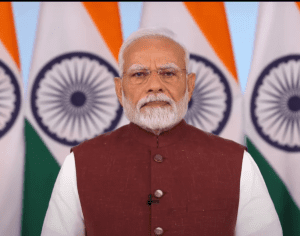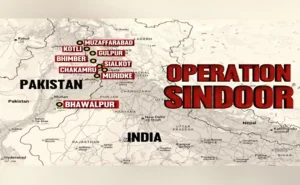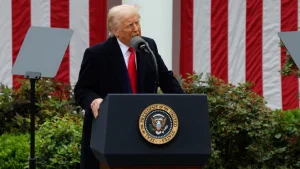New Delhi – Minutes after Prime Minister Narendra Modi addressed the nation on Monday regarding Operation Sindoor, multiple drones spotted in J&K after Modi’s speech raised concerns along the border regions. Security forces successfully intercepted 10 to 12 drones in Jammu and Kashmir’s Samba district, while explosions were also reported from Punjab’s Hoshiarpur district.
Despite these incidents, the ceasefire agreement reached on May 10 between India and Pakistan has largely remained intact. The Directors General of Military Operations (DGMOs) of both countries held talks on Monday evening to discuss their commitment to upholding the understanding reached earlier.
Modi’s Address Highlights India’s Stance Against Terrorism

In his first national address following Operation Sindoor, Prime Minister Modi made it clear that India will not tolerate “nuclear blackmail” from Pakistan. He emphasized that operations against Pakistan have only been paused, with future actions depending on Pakistan’s behavior.
“It’s not an era of war, but also not an era of terrorism,” Modi stated firmly during his address. The Prime Minister referred to the recent Pahalgam attack as the “most barbaric face of terrorism” and said that the enemy now understands the consequences of their actions.
The drones spotted in J&K after Modi’s speech seemed to be a response to his strong stance. However, military sources indicated that comparatively fewer drones were spotted in the Samba region compared to previous incidents.
Also Read: Operation Sindoor Press Conference: Stunning Revelation Of India’s Anti-Terror Strategy
Operation Sindoor: India’s Decisive Action Against Terror Infrastructure


Prime Minister Modi elaborated on Operation Sindoor, calling it “not just a name, but India’s emotion.” He revealed that India had given full freedom to its armed forces to eliminate terrorists, resulting in significant damage to terror infrastructure within Pakistan.
“We hit terror hubs and their courage too,” Modi declared, adding that Pakistan quickly began looking for ways to de-escalate after India’s decisive action. According to military briefings, Indian strikes destroyed 11 air bases inside Pakistan and inflicted considerable damage on their military capabilities.
The drones spotted in J&K after Modi’s speech came shortly after Modi had highlighted how “Pakistan slumped into gloom after the Indian attack on terror camps.”
DGMO Talks Address Continued Commitment to Ceasefire
The DGMO-level talks, which were originally scheduled for noon but began around 5 PM, focused on the key elements of the May 10 agreement. Both sides agreed on the “stoppage of firing and military action” across borders.


Earlier briefings by the Indian military revealed that approximately 35 to 40 Pakistani Army personnel were killed in artillery and small arms fire exchanges along the Line of Control between May 7 and 10. The military reiterated that India’s fight was aimed solely at terrorists and terrorist infrastructure in Pakistan, not against the country’s army.
With drones spotted in J&K after Modi’s speech, the commitment to maintaining the ceasefire was immediately tested but appears to be holding.
Border Situations and Civilian Impact
The border situation has remained relatively calm despite multiple drones spotted in J&K after Modi’s speech. Reports indicate that around 80 percent of people living in border areas had vacated their homes during the height of tensions. Some locals have begun returning home after fleeing Pakistani shelling near the Line of Control.
Schools in border areas of Jammu will remain closed as a precautionary measure, while non-border schools have been cleared to reopen. In Punjab’s Ferozepur, officials announced that schools would reopen from Tuesday as the situation was deemed peaceful.
Flight operations at Srinagar airport are set to resume from Tuesday, while Himachal’s Kangra airport has already reopened for civilian flight operations. However, some flight cancellations continue in affected areas.
International Response to Indo-Pak Tensions
The ceasefire agreement has drawn international attention, with countries like Australia welcoming the development and calling for further de-escalation. U.S. President Donald Trump claimed that the U.S. had stopped a “bad nuclear war” and suggested that trade considerations played a significant role in the decision to cease hostilities.


China denied reports of sending military cargo planes to Pakistan during the tensions, as the Indian military displayed debris of what appeared to be a Chinese-origin PL-15 air-to-air missile.
Military Readiness Remains High
Despite the ceasefire, Indian armed forces maintain high alert levels after the drones spotted in J&K after Modi’s speech. The government released images of the Integrated Air Command and Control System, which was crucial to the success of Operation Sindoor.
Military officials assured citizens that all of India’s military bases remain secured, fully operational, and prepared to address any threats to the country. The interception of drones spotted in J&K after Modi’s speech demonstrated this continued vigilance.
Future Outlook
As both nations navigate this fragile ceasefire, the drones spotted in J&K after Modi’s speech serve as a reminder of ongoing tensions. Prime Minister Modi’s warning that “terror and talks cannot go together” sets clear expectations for Pakistan’s behavior moving forward.
The Indian Foreign Secretary urged Pakistan to approach the situation with “seriousness” and “responsibility” following ceasefire violations on Saturday. With drones spotted in J&K after Modi’s speech, this call for responsibility takes on renewed urgency.
The coming days will be crucial in determining whether the ceasefire holds and if diplomatic channels can be strengthened to prevent further escalation. Meanwhile, border residents and security forces remain vigilant for any drones spotted in J&K after Modi’s speech or other potential threats along the volatile frontier.

